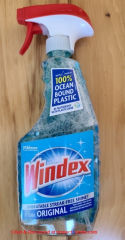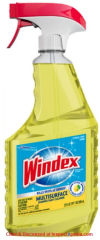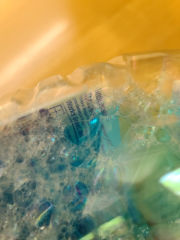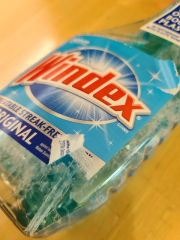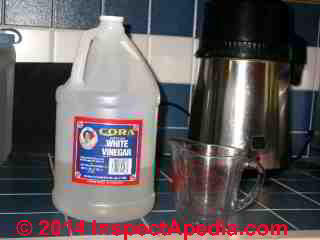 Building Surface Disinfection
Building Surface Disinfection
Products, instructions, wet time, drying time for using disinfectants & sanitizers
- POST a QUESTION or COMMENT about cleaning & disinfecting building surfaces.
Disinfect building surfaces by a combination of pre-cleaning of heavy dirt or debris, selecting an appropriate cleaner or disinfectant solution or spray, and using the product according to its manufacturer's instructions.
Here we provide a table of common surface disinfectants and their application or contact time and use procedures.
InspectAPedia tolerates no conflicts of interest. We have no relationship with advertisers, products, or services discussed at this website.
- Daniel Friedman, Publisher/Editor/Author - See WHO ARE WE?
Disinfection of Building Surfaces
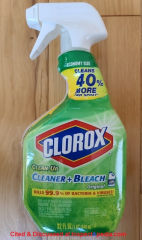 A number of cleaners and disinfectants used on building surfaces, such as in hospitals or when cleaning a building after a sewage backup, but keep in mind that these cleaners, sanitizers, or disinfectants are for building surfaces, not for use on foods such as produce.
A number of cleaners and disinfectants used on building surfaces, such as in hospitals or when cleaning a building after a sewage backup, but keep in mind that these cleaners, sanitizers, or disinfectants are for building surfaces, not for use on foods such as produce.
Shown here: Clorox® "Original" spray cleaner + bleach.
[Click to enlarge any image]
7 Easy Steps for Using A Surface Disinfectant
- Check the cleaning product for approval for its intended use (US EPA list at epa.gov/listn )
- Read the instructions provided by the product manufacturer, usually printed on the product labels
- Pre-clean the surface using ordinary cleaners like soap and water if the surface is visibly dirty or as recommended in your disinfectant product's instructions
- Wear appropriate protective gear before using the disinfectant, such as goggles, disposable gloves, mask
- Apply the disinfectant to the surface as directed, often by spray, wetting the surface
- Wait the required contact time. Some products are wiped off, others are left to air-dry
- Wash your hands after using the product
- Keep harmful chemicals out of reach of children
What's the Difference Between Cleaning, Sanitizing, and Disinfecting?
In order of reduction of pathogens on surfaces we use the US EPA's following definitions:
- Cleaning physically removes germs, dirt, and impurities from surfaces or objects. Cleaning works by using soap (or detergent) and water combined with scrubbing to physically remove germs from surfaces. Cleaners may be soap or detergents combined in water.
This process does not necessarily kill germs, but by removing them, it lowers their numbers and the risk of spreading infection.
For some sanitizers or disinfectants to be effective, depending on the product instructions, the surface may have to be physically cleaned first. - Sanitizing lowers the number of germs on surfaces or objects to a safe level, as judged by public health standards or requirements. Typically a sanitizer's label will indicate that it kills 99% of the organisms ("germs") listed on its label.
Watch out: organisms that are not listed on the sanitizer label may not be killed or may not be killed at that same high level.
This process works by either cleaning or disinfecting surfaces or objects to lower the risk of spreading infection.
A non-food-contact surface sanitizer is “a substance, or mixture of substances, that reduces the bacterial population in the inanimate environment by significant numbers, (e.g., 3-log10 reduction) or
more, but does not destroy or eliminate all bacteria. (EPA Sanitizers 2012)
- Disinfecting kills close to 100% of harmful organisms (germs) on surfaces or objects. Disinfecting works by using chemicals to kill germs on surfaces or objects.
Watch out: Like sanitizers, a disinfectant may not kill some or all of organisms that are not listed on its label.
This process does not necessarily clean dirty surfaces or remove germs, but by killing germs on a surface after cleaning, it can further lower the risk of spreading infection. - (U.S. EPA 2021)
a disinfectant is a “substance, or mixture of substances, that destroys or irreversibly inactivates bacteria, fungi and viruses, but not necessarily their spores. (EPA Pesticide manual 2011)
Below we provide a table of common disinfectant and cleaning products and a summary of how they are used, surface wetting and required contact time.
Surface Disinfection Contact Times (NOT Appropriate for Produce or Other Foods) |
|
| Disinfectant & Application | Contact Time |
| Alcohol | Wet surface, Let evaporate 1 |
| Benzalkonium chloride | see Lysol |
| Bleach disinfectant spray | 10 - 60 min Varies by concentration 2 |
| Botanical disinfectants | 15 - 30 minutes 3 |
| Cavicide spray | Wet 2 min 8 |
| Clorox Non-Bleach disinfecting spray | Wet, 30 seconds, or "a few minutes" 4 |
| Hot Water | for immersed objects 10 |
| Hydrogen Peroxide (accelerated) | See note 12 |
| Iodine 25 ppm | See note 11 |
| Lemon Juice | Questionable - See (Gaulin 2014) |
| Lysol® Spray Disinfectant | Wet 3 min, then air dry 5 |
| Microban® | Wet 1 min, then air dry 6 |
| Purell® Professional Surface Disinfectant | Wet 30 sec, air dry 7 |
| Quaternary Ammonium Compounds (QUATs) 200 ppm |
See notes 1, 9 |
| Vinegar (acetic acid) | Questionable See note 12 See (Gaulin 2014) |
| Windex® Multi surface disinfectant cleaner | Wet 10 minutes, wipe dry 14 |
Notes to the table above
Watch out: these disinfectants are for surface disinfection: they are NOT appropriate for produce or other foods
Watch out: be sure to use disinfectants, sanitizers, and cleaners as directed by the manufacture. Mixing chemicals or cleaners or using in an un-ventilated space or getting a some chemicals in one's eyes or on the skin can be quite dangerous.
- Alcohol surface-disinfectant: Dilute 90% or 70% ethanol or isopropyl alcohol with 30% water to slow evaporation and improve disinfection.
Since alcohol is flammable, limit its use as a surface disinfectant to small surface-areas and use it in well-ventilated spaces only. - U.S. NIH cited at References:
See Rutala, William A., Ph.D., M.P.H. & David J. Weber, M.D., M.P.H., CHEMICAL DISINFECTANTS [PDF] [Live link given at Research: below], U.S. CDC, retrieved 2022/05/15, original source: https://www.cdc.gov/infectioncontrol/guidelines/disinfection/disinfection-methods/chemical.html
Excerpt: Alcohol: In the healthcare setting, “alcohol” refers to two water-soluble chemical compounds—ethyl alcohol and isopropyl alcohol—that have generally underrated germicidal characteristics 482.
FDA has not cleared any liquid chemical sterilant or high-level disinfectant with alcohol as the main active ingredient.
These alcohols are rapidly bactericidal rather than bacteriostatic against vegetative forms of bacteria; they also are tuberculocidal, fungicidal, and virucidal but do not destroy bacterial spores.
Their cidal activity drops sharply when diluted below 50% concentration, and the optimum bactericidal concentration is 60%–90% solutions in water (volume/volume) 483, 484.
This article gives the properties of the following disinfectants:
Alcohol, Chlorine and chlorine compounds, Formaldehyde, Glutaraldehyde, Hydrogen peroxide, Iodophors, Ortho-phthalaldehyde (OPA), Peracetic acid, Peracetic acid and hydrogen peroxide, Phenolics, Quaternary ammonium compounds
- Bleach surface-disinfectant: Dilute household bleach 1/3 cup bleach to 1 gallon of water, leave on surface 6 minutes. Household bleach is sodium hypochlorite - retrieved 2022/05/13, source: https://www.clorox.com/learn/how-to-disinfect-clean-bathtub-shower-with-bleach/
Among disinfectants currently readily available, none is as economical and effective as bleach when properly diluted and applied.
Diluted bleach to 100-200 ppm is recommended (Chen 2020) - see this Online Bleach Calculator from Foodsafe Canada - BC - http://www.foodsafe.ca/dilution-calculator.html - to find the proper amounts of water and bleach to mix.
Watch out: Use cold water when diluting bleach. If your diluting water is hot it will decompose the bleach and may make it ineffective!
Watch out: never mix bleach with ammonia, alcohol, vinegar - you may produce toxic, even fatal gases such as chlorine gas.
Bleach is a strong and effective disinfectant – its active ingredient sodium hypochlorite is effective in killing bacteria, fungi and viruses, including influenza virus – but it is easily inactivated by organic material.
Diluted household bleach disinfects within 10–60 minutes contact time (see TABLE G.1 below for concentrations and contact times), is widely available at a low cost, and is recommended for surface disinfection in health-care facilities.
However, bleach irritates mucous membranes, the skin and the airways; decomposes under heat and light; and reacts easily with other chemicals.
Therefore, bleach should be used with caution; ventilation should be adequate and consistent with relevant occupational health and safety guidance. Improper use of bleach, including deviation from recommended dilutions (either stronger or weaker), may reduce its effectiveness for disinfection and can injure health-care workers. - U.S. NIH cited at References:
SODIUM HYPOCHLORITE CONCENTRATION & USE (BLEACH) Table G.1 [PDF] - retrieved 2022/05/15 original source: https://www.ncbi.nlm.nih.gov/books/NBK214356/table/annexg.t1/
Quoting in entirety minor edits for clarity [Ed.]
Starting bleach solution
Most household bleach solutions contain 5% sodium hypochlorite (50 000 ppm available chlorine).
Recommended bleach dilution
1:100 dilution of 5% sodium hypochlorite is the usual recommendation. Use 1 part bleach to 99 parts cold tap water (1:100 dilution) for disinfection of surfaces.
Adjust ratio of bleach to water as needed to achieve appropriate concentration of sodium hypochlorite. For example, for bleach preparations containing 2.5% sodium hypochlorite, use twice as much bleach (i.e. 2 parts bleach to 98 parts water).
Available chlorine after dilution of bleach
For bleach preparations containing 5% sodium hypochlorite, a 1:100 dilution will yield 0.05% or 500 ppm available chlorine.
Bleach solutions containing other concentrations of sodium hypochlorite will contain different amounts of available chlorine when diluted.
Bleach Contact times for different uses
Disinfection by wiping of nonporous surfaces: a contact time of ≥ 10 minutes is recommended.
Disinfection by immersion of items: a contact time of 30 minutes is recommended.
N.B. Surfaces must be cleaned of organic materials, such as secretions, mucus, vomit, faeces, blood or other body fluids before disinfection or immersion. - Botanical disinfectants: Review the manufacturer's specific instructions for contact time for effective disinfectant using a botanical product
- Clorox® Disinfecting Bathroom Cleaner instructions. - Original cleaner+bleach spray, label instructions (30 seconds) & Clorox bathroom cleaner instructions, retrieved 2022/05/13, source: https://www.clorox.com/products/clorox-disinfecting-bathroom-cleaner/
Clorox® Disinfecting Bathroom Cleaner SAFETY DATA SHEET [PDF] - retrieved 2022/05/13, source: https://www.thecloroxcompany.com/wp-content/uploads/cloroxdisinfectingbathroomcleanerjw.pdf - Lysol Spray Disinfectant Instructions, - retrieved 2022/05/13, source: https://www.lysol.com/products/disinfectant-spray/lysol-disinfectant-spray
Excerpts:
Spray 3 to 4 seconds until covered with mist.
To sanitize: Surfaces must remain wet for 10 seconds then allow to air dry.
To disinfect: Surfaces must remain wet for 3 minutes then allow to air dry. - Microban instructions - retrieved 2022/05/13, source: https://www.wbmason.com/ & https://www.microban24.com/products/sanitizing-spray-fresh/
To sanitize: Pre-clean heavily soiled surfaces. Hold container 6-8” from surface and spray until thoroughly wet. To sanitize hard, non-porous, non-food contact surfaces*: Apply product. Let stand 10 seconds. Wipe clean with a damp cloth.
To sanitize hard, non-porous, non-food contact surfaces for 24 hours*: Apply product. Allow to air dry without wiping. Reapply if surface is scrubbed. To sanitize soft surfaces*: Apply product and let stand for 60 seconds. Let air dry.
To disinfect bacteria & viruses: Pre-clean surface. Hold container 6-8" from surface and spray until thoroughly wet. For bacteria*, let stand for 60 seconds. Wipe with a cloth. For bacteria, viruses and fungi**, let stand for 5 minutes. Wipe with a cloth.
To kill the virus causes COVID-19, spray Microban 24 Sanitizing Spray on a hard, non-porous, non-food-contact surface and allow it to remain wet for 60 seconds. Let the surface air dry without wiping.
*When used as directed, effective against Pseudomonas aeruginosa, Staphylococcus aureus, Salmonella enterica, Escherichia coli 0157:H7, Enterobacter aerogenes, Listeria monocytogenes, Methicillin resistant staphylococcus aureus (MERSA), and streptococcus pyogenes.
**When used as directed, effective against bacteria (Pseudomonas aeruginosa, Staphylococcus aureus, Salmonella enterica, Escherichia coli 0157:H7, Enterobacter aerogenes, Listeria monocytogenes, Methicillin Resistant Staphylococcus aureus, and Streptococcus pyogenes), viruses (Influenza A H1N1, Respiratory Syncytial Virus [RSV] and Human Coronavirus, Herpes Simplex virus type 1, Herpes Simplex virus type 2, Rhinovirus Type 39, and Norovirus & Rotavirus) and fungi (i Trichophyton mentagrophytes, and Aspergillus niger). - Purell, PURELL PROFESSIONAL SURFACE DISINFECTANT Technical Bulletin [PDF] (2018) GOJO Industries, Inc.
One GOJO Plaza, Suite 500 P.O. Box 991 • Akron, OH 44309-0991 Tel: 1-330-255-6000 • Toll-free: 1-800-321-9647 Fax: 1-800-FAX-GOJO
PURELL PROFESSIONAL DISINFECTANT MSDS [PDF] (2015) - Metrex, CaviCide - retrieved 2022/05/13, source: https://www.metrex.com/ - instructions for use were not easy to find at the company's website but we did find US EPA advice cited just below [Ed.]
CAVICIDE PRODUCT LABEL INSTRUCTIONS [PDF] (2011) - retrieved 2022/05/13, source: http://legacy.picol.cahnrs.wsu.edu/~picol/pdf/OR/30443.pdf
CAVICIDE INSTRUCTIONS for USE [PDF] (1994) [may be obsolete - Ed.] - retrieved 2022/05/13, source: https://www3.epa.gov/pesticides/chem_search/ppls/038526-00001-19950117.pdf
Excerpts:
For disinfecting non-critical devices/medical equipment and other surfaces:
Spray/apply Cavicide directly to surface, thoroughly wetting area to be disinfected. (Visibly soiled surfaces should be pre-cleaned.)
Allow surface to remain wet for 2 minutes. ( FOR TUBERCULOCIDAL ACTIVITY: Allow surface to remain wet for 10 minutes at room temperature (20'C).)
Follow by wiping surface with a fresh, clean, paper or cloth towel; or rinse and either allow surface to air dry or wipe rinsed surfr.lce dry using a fresh, clean, paper or cloth towel. Discard towel. •
Cavicide completely inactivates the HIV-1 (AIDS virus) on hard, non-porous surfaces in the presence of a moderate amount of organic soil (S% blood serum) with a contact time of 2 minutes at room temperature (20-2S'C) . - Quats, at 200 ppm or less do not require rinsing. Follow the manufacturer's instructions. (Chen 2022)
- Hot water as disinfectant: For objects that can be immersed in hot water at 77°C or above, immerse for no less than 45 seconds. (Chen 2022)
- Iodine: at 25 ppm may be used for surface cleaning; follow the manufacturer's instructions. (Chen 2022)
- Hydrogen peroxide can damage some items such as cellphones, and may react with bleach to produce dangerous chlorine gas.
- Vinegar's disinfectant properties:
Health Canada on Vinegar,
also see David Suzuki's Foundation & "Does Vinegar Kill Germs" - https://davidsuzuki.org/
Excerpt:
Acetic acid (a.k.a. white vinegar) can act as a disinfectant that can destroy some bacteria and viruses.
There is no scientific evidence or studies that show vinegar kills a virus like COVID-19.
Studies confirming vinegar’s antibacterial properties:
Household natural sanitizers like lemon juice and vinegar reduced the number of pathogens to undetectable levels.
Vinegar can inhibit growth of and kill some food-borne pathogenic bacteria. Plus, vinegar’s bactericidal activity increased with heat! (Salt helped, too.)
“The combined use of vinegar and sodium chloride, with use of an appropriate treatment temperature, was found to be markedly effective for the prevention of bacterial food poisoning.”
Household disinfectants — vinegar and baking soda used on their own — were highly effective against potential bacterial pathogens but less effective than commercial household disinfectants.
Note: Health Canada states, “Products such as tea tree oil, baking soda, vinegar, electrolyzed water, microfibre cloths, ozone, and silver compounds are not registered disinfectants for food premises, according to the Health Canada definition.”
- Windex® Original glass cleaner, the blue liquid spray bottle shown above, contains ammonia but is not a disinfectant; the company provides other products that include disinfectants, including:
Windex® Multisurface disinfectant cleaner, the lemon-yellow colored liquid and bottle shown above, is described by its manufacturer, SC Johnson Professional, as shown below.
Instructions for using this disinfectant are at https://www.windex.com/en-us/products/disinfectant-cleaner-multi-surface
Website excerpt:
This product will clean and shine surfaces without any dull residue. When used as directed, it kills 99.9% of germs‡ and bacteria† on hard, non-porous surfaces. Great for cleaning bathrooms, kitchens, tiles, stainless steel, and more.
‡Staphylococcus aureus, Salmonella enterica, Pseudomonas aeruginosa, Streptococcus pyogenes, Rhinovirus Type 37 (common cold), Influenza A2/Hong Kong (Influenza)(H1N1) (flu) (virus), Influenza B †Staphylococcus aureus, Enterobacter aerogenes, Escherichia coli, Salmonella enterica, Listeria monocytogenes, Streptococcus pyogenes. Use pesticides safely. Always read label and product information before use.
Windex® Multisurface DISINFECTANT CLEANER MSDS [PDF] S.C. Johnson & Son, Inc. 1525 Howe Street Racine WI 53403-2236 - this SDS shows that this product contains a combination of lactic acid and Ethyleneglycol Monohexylether, considered "non-hazardous" - excerpting: This product does not meet the criteria for classification in any hazard class according to regulation
OSHA 29 CFR 1910.1200.
Windex® Original Glass Cleaner MSDS [PDF] Op. Cit. also considered "not hazardous: - MSDS excerpts: This product does not meet the criteria for classification in any hazard class according to regulation
OSHA 29 CFR 1910.1200 ... This product does not contain hazardous chemicals at or above a reportable level as defined by OSHA 29 CFR 1910.1200
What are the ingredients in Windex Glass Cleaner? The MSDS for this product does not list its ingredients but states For additional information on product ingredients, see www.whatsinsidescjohnson.com.
Really? Information about Windex Original glass cleaner is provided on the back-side of the label but we found that nearly impossible to read and impossible to peel away from the container. When the container is empty, of course, one can read its label-back text.
Windex original glass cleaner is not listed at that company website, though we can find Windex® Commercial Glass Cleaner Formula 35*14153 that lists these ingredients and their purpose: WaterWater 2-Hexoxyethanol - Cleaning Agent, Isopropanolamine - Cleaning Agent, Ammonium Hydroxide - Cleaning Agent, Lauryl Dimethyl Amine Oxide - Wetting Agent, Sodium Dodecylbenzene Sulfonate - Wetting Agent, Fragrance, Liquitint® Sky Blue DyeDye
- Consider simple soap and water for common surface cleaning.
Ineffective or Improperly-Used Products Sold, Promoted, as Surface Disinfectants
Ammonia (NH3), or ionized ammonia (NH4), a very widely-used cleaning product, is not a disinfectant, though ammonia is used in the production of "Quats" or QACs - quaternary ammonium compounds that are used as a disinfectant in many applications. Ammonia is widely used in household cleaning products including window cleaners, in part because mixed in water it both assists in cleaning and because it evaporates quickly.
Windex glass cleaner, one of our personal favorite glass and marble countertop cleaners, is also not a disinfectant, though its manufacturer, SC Johnson does provide other products that are used as surface disinfectants and cleaners.
Other products such as tea tree oil, baking soda, vinegar, electrolyzed water, microfibre cloths, ozone, and silver compounds are not registered disinfectants for food premises, according to the Health Canada definition. (Gaulin 2014, rev)
Watch out: the guidelines and purposes of cleaning or disinfecting building surfaces and the products suitable for use on building surfaces are quite different from those used to disinfect produce - things to be eaten by people or other animals.
Examples of such disinfectants taht are NOT safe for use on foods include concentrated bleach, rubbing alcohl, ethanol, quat-based cleaners, or Lysol.
See also
VEGETABLE or PRODUCE DISINFECTION
Research: Building Surface Disinfection & Soaks, Sprays, Washes
- Ascenzi, Joseph M. (Ed), Handbook of Disinfectants and Antiseptics, Joseph M. CRC, 1995, ISBN-10: 0824795245 ISBN-13: 978-0824795245 "The evaluation of chemical germicides predates the golden age of microbiology..." -
This well-focused, up-to-date reference details the current medical uses of antiseptics and disinfectants -- particularly in the control of hospital-acquired infections -- presenting methods for evaluating products to obtain regulatory approval and examining chemical, physical, and microbiological properties as well as the toxicology of the most widely used commercial chemicals. - AMMONIA Pub-Chem Properties [PDF] U.S. NIH, https://pubchem.ncbi.nlm.nih.gov/compound/Ammonia
- CA, CHP, SANITIZE SAFELY AND EFFECTIVELY: BLEACH AND ALTERNATIVES IN CHILD CARE PROGRAMS [PDF] (2009) California Childcare Health Program, CA Departmentof Environmental Protection, California Department of Pesticide Regulation, California Childcare Health Program, a program of the Universitiy of California, San Francisco School of Nursing
1950 Addison Street, Suite 107 Berkeley, CA 94704-1182 UDA Tel: 510–204-0930 Healthline 1-800-333-3212 www.ucsfchildcarehealth.org - retrieved 2022/05/13, original source: https://cchp.ucsf.edu/sites/g/files/tkssra181/f/SanitizeSafely_En0909.pdf
Includes detailed instructions on using bleach as a surface disinfectant. - Chen, Tina, REDUCING COVID-19 TRANSMISSION THROUGH CLEANING AND DISINFECTING HOUSEHOLD SURFACES [PDF], (2020) Health Canada, NCCEH, retrieved 2022/05/13 original source:https://ncceh.ca/documents/guide/reducing-covid-19-transmission-through-cleaning-and-disinfecting-household-surfaces
Excerpt: The primary mode of human-to-human transmission for SARS-CoV-2, the virus responsible for coronavirus disease (COVID-19), is via direct contact with an infected person and their respiratory droplets, expelled during coughing, sneezing, speaking, or breathing.1,2 These droplets can be inhaled or become deposited on surfaces such as door handles, light switches, chairs, faucets, and other frequently touched surfaces. - Culveer, Alicia, Chris Geiger, Ph.D., Deanna Simon,SAFER PRODUCTS and PRACTICES for DISINFECTING and SANITIZING SURFACES [PDF] SF Environment, 1455 Market St., San Francisco, CA 94103, USA, Web: SFEnvironment.org, Tel: 415-355-3700, retrieved 2022/05/13 original source: https://sfenvironment.org/sites/default/files/fliers/files/sfe_th_safer_products_and_practices_for_disinfecting.pdf
Overview excerpts:
Nearly all public facilities – such as schools, parks and office buildings – use a substantial amount of surface sanitizing and disinfecting products while cleaning their restrooms and other public spaces. These products are inherently toxic, as they are formulated to kill living organisms.
As such, the U.S. Environmental Protection Agency (U.S. EPA) and California Department of Pesticide Regulation (CA DPR) register all surface sanitizers and disinfectants as pesticides.
Although all of these “antimicrobial” products have risks, there are a few types that pose greater, long-term risks to custodial workers and building occupants because they contain active ingredients that have been found to cause asthma (e.g., chlorine bleach/sodium hypochlorite, peroxyacetic acid, and quaternary ammonium compounds), cancer (e.g., ortho-phenylphenol), skin sensitization (e.g., chlorine bleach, pine oil, and thymol) or other health hazards.
Several also pose environmental risks as well, such as silver and quaternary ammonium chloride compounds.
Surface sanitizers and disinfectants with more benign health and environmental impacts are available and often have equivalent or greater efficacy.
However, these products have been difficult for purchasers to identify because US law prohibits the use of ecolabels on EPA-registered pesticides, and because of the complex nature of the problem; that is, consideration must be given to efficacy against a variety of pathogens, as well as factors such as surface compatibility and dwell time. - Gaulin, Fong G., Lê M-L, Shum M, EFFECTIVENESS OF ALTERNATIVE ANTIMICROBIAL AGENTS FOR DISINFECTION OF HARD SURFACES - revised, [PDF] (2014) Health Canada, NCCEH, retrieved 2022/05/13 original source: https://ncceh.ca/documents/evidence-review/effectiveness-alternative-antimicrobial-agents-disinfection-hard-surfaces
Summary excerpts:
A review of alternative antimicrobial agents reveals the need for standardized methodology for efficacy testing as well as considerations of toxicity, safety, cost, ease of use, availability, storage, and applicationspecific testing.
The appropriateness of alternative antimicrobial agents, such as vinegar, lemon juice, and baking soda appear to be limited for commercial disinfection or sanitization, but some emerging technologies such as ozonated water and electrolyzed water have demonstrated substantial antimicrobial properties.
Agents such as tea tree oil may demonstrate notable antimicrobial efficacy, but toxicity and lack of testing on hard surfaces limit their applications for hard surface disinfection.
Thyme oil exhibits low toxicity and has been shown to be microbicidal, but its use may be limited due to the need for long contact time and costs - Gaulin C, Lê M-L, Shum M, Fong D, DISINFECTANTS AND SANITIZERS FOR USE ON FOOD CONTACT SURFACES - revised [PDF] (2011) Health Canada, NCCEH, retrieved 2022/05/13
- G2-Solutions, Germstrike disinfectant, 6 Grandview Street
Phone: 401-823-4400
Mobile: 1-888-GERMSTK (437-6785)
Email: info@germstrykeclean.com
Web: germstrykeclean.com
Website excerpt:
G2 Solutions has developed GermStryke 250, which is a hypochlorous acid (HOCI) based disinfecting cleaner that is superior to competitive products currently available on the market.
GermStryke 250 has been engineered to yield a powerful, stable, and residue-free disinfecting cleaner for a wide variety of applications. - Ipswich DOH, GUIDELINES ON THE USE OF DISINFECTANTS [PDF] Ipswich, MA, Town Hall 25 Green Street Ipswich, MA 01938 Phone: 978-356-6600- retrieved 2022/05/15 original source: https://www.ipswichma.gov/DocumentCenter/View/10072/50ppm-Guidelines-on-the-Use-of-Disinfectants
- Russell, A.D. (Ed), W. B. Hugo (Editor), G. A. J. Ayliffe (Editor), Principles and Practice of Disinfection, Preservation and Sterilization (Hardcover)
Blackwell Science, 2004. ISBN-10: 1405101997, ISBN-13: 978-1405101998.
"This superb book is the best of its kind available and one that will undoubtedly be useful, if not essential, to workers in a variety of industries. Thirty-one distinguished specialists deal comprehensively with the subject matter indicated by the title
... The book is produced with care, is very readable with useful selected references at the end of each chapter and an excellent index. It is an essential source book for everyone interested in this field. For pharmacy undergraduates, it will complement the excellent text on pharmaceutical microbiology by two of the present editors."
The Pharmaceutical Journal: "This is an excellent book. It deals comprehensively and authoritatively with its subject with contributions from 31 distinguished specialists.
There is a great deal to interest all those involved in hospital infection ... This book is exceptionally well laid out. There are well chosen references for each chapter and an excellent index. It is highly recommended."
The Journal of Hospital Infection.: "The editors and authors must be congratulated for this excellent treatise on nonantibiotic antimicrobial measures in hospitals and industry ... The publication is highly recommended to hospital and research personnel, especially to clinical microbiologists, infection-control and environmental-safety specialists, pharmacists, and dieticians."
New England Journal of Medicine: City Hospital, Birmingham, UK. Covers the many methods of the elimination or prevention of microbial growth. Provides an historical overview, descriptions of the types of antimicrobial agents, factors affecting efficacy, evaluation methods, and types of resistance.
Features sterilization methods, and more. Previous edition: c1999. DNLM: Sterilization--methods. - Rutala, William A., Ph.D., M.P.H. & David J. Weber, M.D., M.P.H., CHEMICAL DISINFECTANTS [PDF] U.S. CDC, retrieved 2022/05/15, original source: https://www.cdc.gov/infectioncontrol/guidelines/disinfection/disinfection-methods/chemical.html
- Rutala, William A., Susan L. Barbee, Newman C. Aguiar, Mark D. Sobsey, and David J. Weber. "Antimicrobial activity of home disinfectants and natural products against potential human pathogens." Infection control and hospital epidemiology 21, no. 1 (2000): 33-38. Abstract
RESULTS. The following compounds demonstrated excellent antimicrobial activity (>5.6‐8.2 log10 reduction) at both exposure times: TBQ, Vesphene, Clorox, ethanol, and Lysol Antibacterial Kitchen Cleaner. Mr. Clean eliminated 4 to >6 logs10 and Lysol Disinfectant ∼4 logs10 of pathogenic microorganisms at both exposure times.
Vinegar eliminated <3 logs10 of S aureus and E coli, and baking soda <3 logs10 of all test pathogens. All tested chemical disinfectants completely inactivated both antibioticresistant and ‐susceptible bacteria at both exposure times.
Only two disinfectants, Clorox and Lysol, demonstrated excellent activity (>3 log10 reduction) against poliovirus. - U.S. EPA, HOW TO CLEAN AND DISINFECT SCHOOLS TO HELP SLOW THE SPREAD OF FLU [PDF] (2021) Centers for Disease Control and Prevention, National Center for Immunization and Respiratory Diseases (NCIRD)
- U.S. EPA, 6 STEPS in USING ANY DISINFECTANT ON or ON BUILDINGS [PDF] (2020) U.S. Environmental Protection Agency, - retrived 2022/05/13, original source: https://www.epa.gov/sites/default/files/2020-04/documents/disinfectants-onepager.pdf
- U.S. EPA, GUIDANCE FOR CLEANING AND DISINFECTING PUBLIC SPACES, WORKPLACES, BUSINESSES, SCHOOLS, AND HOMES [PDF] (2020) U.S. Environmental Protection Agency, - retrived 2022/05/13, original source: epa.gov/sites/default/files/2020-04/documents/316485-c_reopeningamerica_guidance_4.19_6pm.pdf
- US Environmental Protection Agency, Sanitizer Test for Inanimate Surfaces, Last updated May 9, 2012; Original source: http://www.epa.gov/oppad001/dis_tss_docs/dis‐10.htm
- US Environmental Protection Agency, Pesticide Registration Manual: Chapter 4 – Additional Considerations for Antimicrobial Products, “Types of Antimicrobial Pesticides: Sanitizers”, Last updated August 2011;
Original source: http://www.epa.gov/pesticides/bluebook/chapter4.html - U.S. NIH, USE of DISINFECTANTS, ALCOHL & BLEACH [PDF] - retrieved 2022/05/15 original source: https://www.ncbi.nlm.nih.gov/books/NBK214356/
- WHO, INFECTION PREVENTION AND CONTROL OF EPIDEMIC- AND PANDEMIC-PRONE ACUTE RESPIRATORY INFECTIONS IN HEALTH CARE WHO GUIDELINES [PDF] (2014) 156 pages, World Health Organization, from U.S. NIH, retrieved 2022/05/15 original source: https://www.ncbi.nlm.nih.gov/books/NBK214359/pdf/Bookshelf_NBK214359.pdf
...
Continue reading at DISINFECTANTS, SANITIZERS, FUNGICIDAL-SEALANTS SOURCES or select a topic from the closely-related articles below, or see the complete ARTICLE INDEX.
Or see these
Recommended Articles
- BLEACH DISINFECTANT for DRINKING WATER
- DISINFECTANTS, SANITIZERS, FUNGICIDAL-SEALANTS SOURCES
- DRINKING WATER EMERGENCY PURIFICATION
- FLOOD DAMAGE ASSESSMENT, SAFETY & CLEANUP
- FUNGICIDAL SEALANT USE GUIDE
- MOLD CLEANUP with BLEACH
- MOLD CLEANERS - WHAT TO USE
- SEWAGE BACKUP, WHAT TO DO
- SIDING, WOOD CLEANERS, STAINS, PAINTS
- VINEGAR for PRODUCE or WATER DISINFECTION
- WATER DISINFECTANT QUANTITY
- WELL CHLORINATION & DISINFECTION
Suggested citation for this web page
DISINFECTION of BUILDING SURFACES at InspectApedia.com - online encyclopedia of building & environmental inspection, testing, diagnosis, repair, & problem prevention advice.
Or see this
INDEX to RELATED ARTICLES: ARTICLE INDEX to WATER TREATMENT SYSTEMS
Or use the SEARCH BOX found below to Ask a Question or Search InspectApedia
Ask a Question or Search InspectApedia
Try the search box just below, or if you prefer, post a question or comment in the Comments box below and we will respond promptly.
Search the InspectApedia website
Note: appearance of your Comment below may be delayed: if your comment contains an image, photograph, web link, or text that looks to the software as if it might be a web link, your posting will appear after it has been approved by a moderator. Apologies for the delay.
Only one image can be added per comment but you can post as many comments, and therefore images, as you like.
You will not receive a notification when a response to your question has been posted.
Please bookmark this page to make it easy for you to check back for our response.
IF above you see "Comment Form is loading comments..." then COMMENT BOX - countable.ca / bawkbox.com IS NOT WORKING.
In any case you are welcome to send an email directly to us at InspectApedia.com at editor@inspectApedia.com
We'll reply to you directly. Please help us help you by noting, in your email, the URL of the InspectApedia page where you wanted to comment.
Citations & References
In addition to any citations in the article above, a full list is available on request.
- Dr. Omar Amin, of the Tempe AZ Parasitology Center, corresponded with one of our readers asking about peroxide: "You can use hydrogen peroxide if you want to but we do not have a track record of percentage dilution". Dr. Amin has done research for the US military and for the CDC.
- Our recommended books about building & mechanical systems design, inspection, problem diagnosis, and repair, and about indoor environment and IAQ testing, diagnosis, and cleanup are at the InspectAPedia Bookstore. Also see our Book Reviews - InspectAPedia.
- In addition to citations & references found in this article, see the research citations given at the end of the related articles found at our suggested
CONTINUE READING or RECOMMENDED ARTICLES.
- Carson, Dunlop & Associates Ltd., 120 Carlton Street Suite 407, Toronto ON M5A 4K2. Tel: (416) 964-9415 1-800-268-7070 Email: info@carsondunlop.com. Alan Carson is a past president of ASHI, the American Society of Home Inspectors.
Thanks to Alan Carson and Bob Dunlop, for permission for InspectAPedia to use text excerpts from The HOME REFERENCE BOOK - the Encyclopedia of Homes and to use illustrations from The ILLUSTRATED HOME .
Carson Dunlop Associates provides extensive home inspection education and report writing material. In gratitude we provide links to tsome Carson Dunlop Associates products and services.


